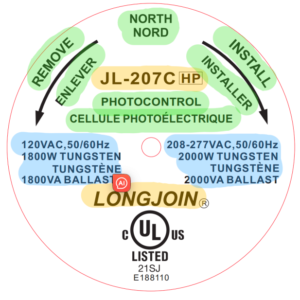How to choose best Photocontrol Receptacles
Introduce
When it comes to street lighting, the level of illumination i.e. how bright a light should shine on the road has significant importance. This is because street lights have a crucial role to play in mitigating the unpleasant incidents of road accidents. A light that is too bright can cause road glare and that may lead to accidents due to obstructed visibility. Similarly, an overly dim light can reduce visibility as well.
Hence, the illumination threshold needs to be set very carefully to make sure the brightness is neither too high to cause glare nor too low to restrict visibility. This is a task that requires utmost vigilance and following the best practices.
Over the years, illumination control threshold has been attained by keeping in view the most appropriate practices and they shape market trends for the manufacturers. The things like local energy efficiency regulations, the need for better control over lighting systems, and intelligent adaptability have been weighing in heavily in the recent years while adjusting brightness thresholds. This is the reason, LONG-JOIN.com has been incorporating the latest technology in its product line to keep up with the vibrant market trends.
Let’s have a look at what are the most advanced market trends and practices in setting illumination control thresholds for street lights.
Increased Reliance on LED lighting
The street lights industry has experienced an immense increase in the use of LED lights. This is because LED can be controlled more efficiently and these are more durable. Besides they are more promising in their performance when it comes to conserving maximum power. Due to better control, you can conveniently adjust the brightness of LED lights and adjust a suitable illumination threshold.
Enhanced Control Over Brightness

The control system has undergone a lot of advancement when it comes to setting illumination thresholds in street lights. A comprehensive network of cameras, detectors, and sensors helps provide better control over the dimming mechanism keeping in view changing conditions on the ground. For example, the ground variables like traffic density, whether or not there are pedestrians, time of the day, and weather act as main determinants to adapt the brightness accordingly.
Area-Specific Tailored Lighting
Many photocontrol outdoor light manufacturers provide municipalities with an option to order specially tailored lighting systems for their streets. The authorities are given the option to select an illumination threshold depending on where the lights are to be installed and what are the ground factors of that area. This can help provide highly need-based lighting and hence can lead to maximum energy conservation along with maintaining the highest standards of safety.
Rules About Energy Efficiency

In various regions around the world, the local authorities have issued specific regulations regarding energy conservation. The street lighting systems are adjusted accordingly when it comes to setting an illumination threshold. Hence, the local rules weigh in heavily while deciding the brightness threshold for street lights in any specific region.
Mimicking Daylight
There is an increasing trend of setting the brightness threshold, especially during the day, to mimic the natural light. It helps provide a brightness level that is easy on human eyes, so people can adapt to it more comfortably.
Data Analysis for Optimal Results

Collecting and analyzing data from different areas and using machine learning algorithms can help reach a better decision regarding the threshold settings. This is being done to ensure the highest efficiency and utility of street lighting. Besides it helps reduce the chances of power wastage.
Remotely controlled Lighting System
A centrally controlled streetlight system allows better monitoring and controlling of the intensity of light. All the lights in a system are centrally controlled and commands can be issued for the entire network depending upon the ground conditions. This also helps in detecting any discrepancies or faults in the system. Besides you are allowed to adjust the brightness threshold remotely as the weather conditions and traffic intensity change.
Aesthetics and Urban Planning
Many developed urban centers around the world are attaching a lot of importance to aesthetics. Efforts are made in such areas to reduce light pollution and the focus is also on ensuring that the lighting system is well adapted to the urban development plan. The streetlighting should enhance the city’s beauty making it aesthetically pleasing. Hence, the light intensity and illumination threshold are set in a way that they incorporate into the overall persona of the cities.
Aesthetics and Urban Planning
Adjusting an illumination threshold and controlling it has become an intricate mechanism taking into account a number of factors. . Modern-day streetlight illumination control system is designed keeping in view the need for adaptability according to changing conditions of the ground. Moreover, the city planners want to ensure that the lighting system blends well with the city’s design instead of creating light pollution and feeling too outrageous. Besides, the advanced lighting thresholds control system takes into account the adaptability of human sye to a level of brightness, hence making it closer to nature and mimicking daylight intensity. All these factors play their role in shaping today’s illumination threshold control system.






